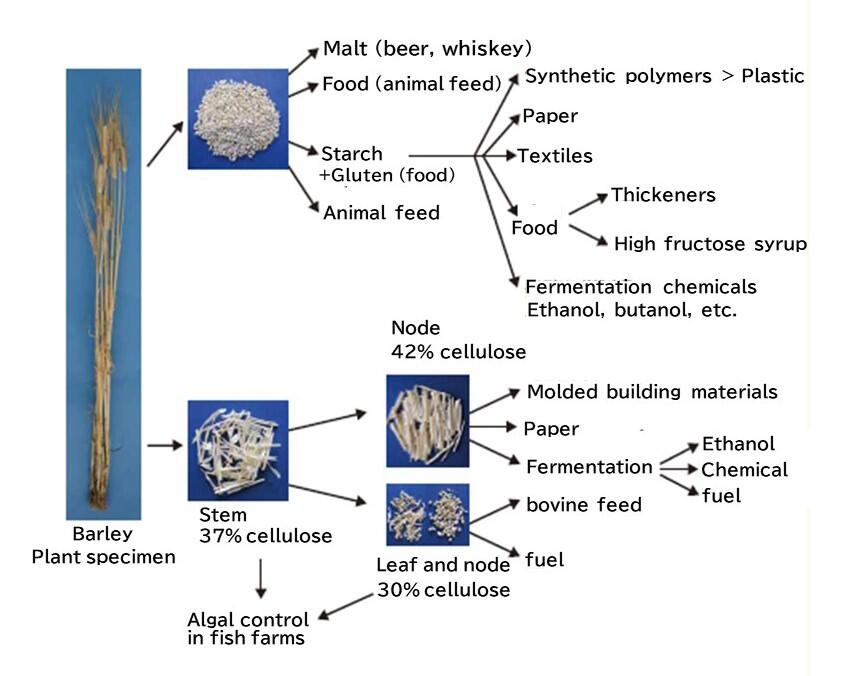As we confront the social challenges of climate change and population growth, there are rising concerns over a food crisis. Amid such a situation, breeding based on genomic data is expanding the possibilities for cereal production, thanks to genome sequencing of the major cereals: barley and wheat.
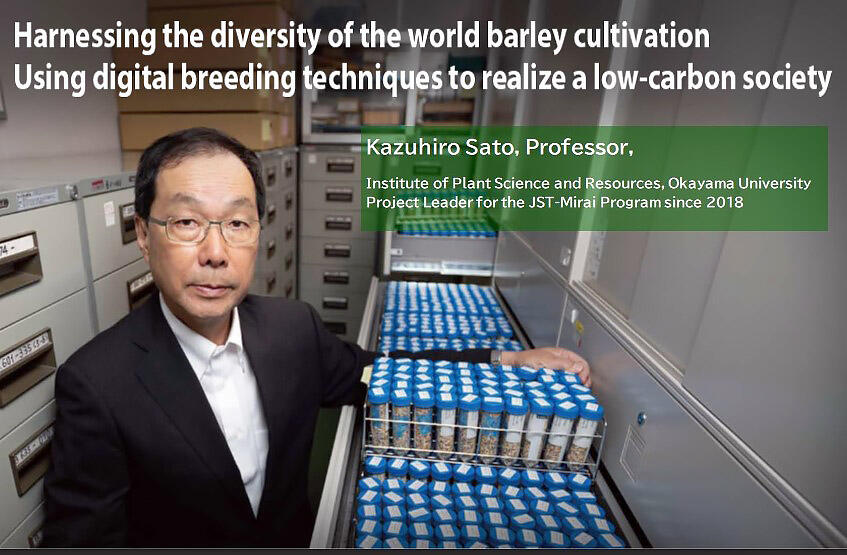
Project Leader for the JST-Mirai Program since 2018
Harnessing the diversity of the world barley collection
Using digital breeding techniques to realize a low-carbon society
Genetic sequences and genomic sequences in the form of digital data are increasingly treated as resources that are just as vital as the living organisms themselves. Professor Kazuhiro Sato at the Institute of Plant Science and Resources, Okayama University is working to establish "digital breeding" in which efficiently creating useful barley cultivars will be done using the diverse lines of barley, which is said to reach 500,000 accessions worldwide. Until the day useful genes are discovered, the digital information and seeds are kept together in storage for future use.
International team takes more than 10 years to solve the sequence jigsaw puzzle
Barley was first cultivated around 10,000 years ago in the Middle East. Since then, it has been distributed around the world, giving rise to a large number of cultivars (Fig. 1). Its major uses are fermented or distilled beverages like beer and whiskey, as well as a human food and feed for animals. Going forward, development of cultivars suited to new uses are sought after, such as for cultivation in regions where desertification is progressing by using the adaptability trait of barley to the cold, dry and salt accumulated environments where other crops have difficulty in growing, or as a biomass source to help stop global warming.
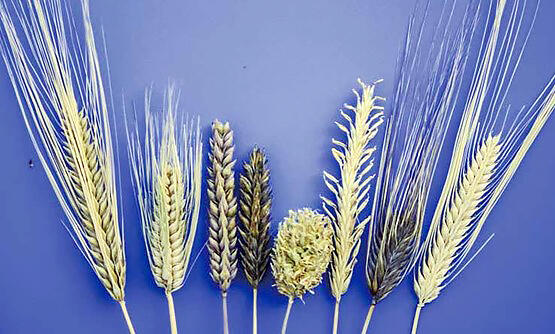
Traditionally, plant breeding has been a matter of crossing lines of differing traits--one that tastes good yet is susceptible to disease with another that tastes poor yet is disease-resistant, for example--to create a crop that combines the best of both. In recent years, breeding that uses genetic sequence information about plants has also been steadily progressing. Professor Kazuhiro Sato at Okayama University's Institute of Plant Science and Resources is one of those who has been involved in research on barley breeding since his student days. "The human genome sequencing was big news in 2003, but the barley genome is huge, 1.7 times the size of the human genome and 13 times larger than that of rice. Sequencing of the barley genome with high-accuracy is not easy," he says.
Professor Sato decided to participate in an international project launched with the aim to sequence the barley genome to enhance the prospects of breeding in the future and announced a draft sequence of one genotype in 2012. Next, he worked on the sequencing of sections of over 20,000 barley accessions, selected a diverse set of 20 genotypes, and conducted genome sequencing. Looking back, he recalls, "Barley has seven chromosomes, but we just had fragments for the DNA sequences back then. Like a jigsaw puzzle, we rearranged fragmented sequences and reconstructed them into individual chromosomes." Members of the project in other countries managed to markedly increase the sequencing capacity that could be done at once, and so step by step, the speed of sequencing accelerated. It took over 10 years, and in 2020 the sequencing of the whole genome of the 20 genotypes was finally completed.
The analysis revealed that only 63% of the gene regions in the 20 genotypes were common sequences, while up to 37% were different. These differing regions contain genetic information leading to the traits of each genotype. If we know the origin of traits and sequences, it will be a major clue when creating new cultivars. Okayama University preserves a collection of barley collected around the world, and Sato describes his outlook, "Even today, we are continuing to sequence the genome. Thanks to dramatic recent advances in sequencing technology, we have completed the sequencing of an extra two genotypes, with three more underway now. Plant digital sequence information is a vital asset today. I hope this will lead to 'digital breeding' using genomic data."
Both living organisms and genes are resources
Enabling the tracking of breeding
While barley may be a natural product, ever since it was first cultivated in the Middle East, it has been distributed worldwide and improved according to the local climate and natural conditions of respective regions. As a result, it has become a unique resource developed in association with each region. Regarding the current situation, Professor Sato explains, "It might generate great return if we could develop new drugs based on compounds extracted from plants that grow in specific regions. Therefore, countries around the world regard these living organisms as genetic resources and are protecting them under the Convention on Biological Diversity . These trends towards genetic resource protection are extended to crops as well."
As part of the barley research which began at Okayama University in the 1940s, a large number of wild and cultivated barley lines were collected from around the world. These accessions number over 20,000 (Fig. 2). Many of the stored accessions were collected before the Convention on Biological Diversity entered into force in 1993, but Okayama University has been collecting valuable seeds in partnership with research institutions around the world ever since. A time may come when the registration of a new cultivar requires genome sequence data. Properly recognizing the value of useful genetic resources will expand the possibilities of digital breeding.
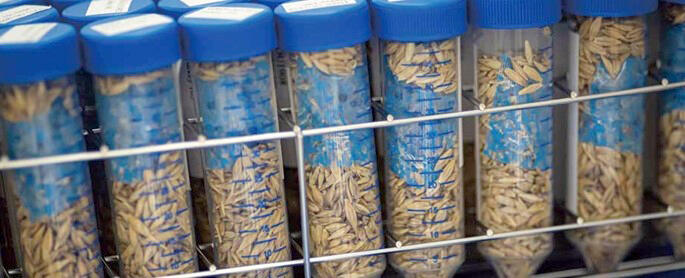
Largest seedbank in the world - a 21st century Noah's Ark
The preservation of barley seeds is as big a challenge as genome sequencing. Just as climate change threatens species with extinction, crops will disappear before we know it if no farmers and growers grow them due to the crops' unsuitable traits in relation to growing conditions and the needs of the time. In the past, barley was a very common crop in Japan, but today, only roughly 10 cultivars are grown in the country. Okayama University is a member of the Ministry of Education, Culture, Sports, Science and Technology's National BioResource Project , which collects, preserves, and distributes bioresource samples to life sciences research. The university supplies seed samples to barley researchers in Japan and worldwide.
The National Agriculture and Food Research Organization also deposits duplicate samples in preparation for a disaster or other incidents, while some 5,000 samples are deposited to the Svalbard Global Seed Vault in the Arctic Circle (Fig. 3). Professor Sato swells with pride and explains, "It stores 100,000 barley accessions from around the world and is called a modern-day Noah's Ark. Compared to others, Okayama University's accessions are rigorously sorted into samples, which are highly evaluated globally for their accurately documented sources."
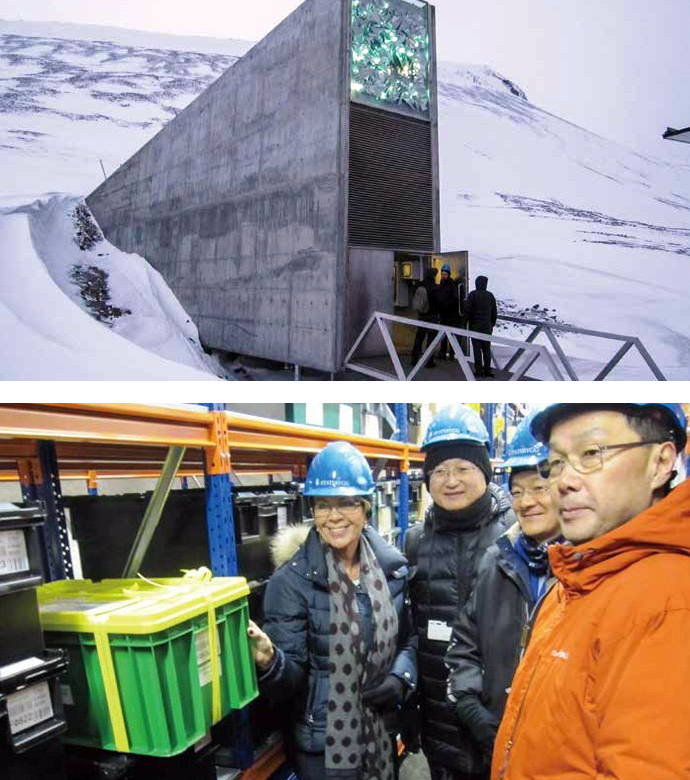
There are cases in which the seeds stored at Okayama University have proved their worth. Ethiopia in Africa faces soil acidification due to the overuse of chemical fertilizers and yields of barley, a staple food, have decreased significantly. In collaborative research with Ethiopia's Hawassa University , Professor Sato discovered that Murasakimochi, an old Japanese barley landrace, has tolerance to acid soils. The team crossed it with local barley to develop a new line. Murasakimochi is thought to have developed acid tolerance from growing in Japanese soils, which are rich in volcanic ash, but is very rarely grown in Japan today. Sato exclaims, "This is something that only worked because of the long-term preservation of seeds. I intend to make continued contributions to the world by supplying techniques for selecting seeds and tolerance genes."
Development of new varieties for use in beer making
Potential to replace plastics
The Okayama University barley collection also demonstrates its worth in industrial research and development. One example is the new barley variety 'Kitanohoshi' developed in research collaboration with Sapporo Breweries Ltd ., headquartered in Shibuya, Tokyo. Beer is said to be best served fresh. This is because with the passage of time, an enzyme contained in barley malt oxidizes the fats in beer, which then cause loss of flavor. The research team identified a genotype of barley that does not contain this enzyme and developed it as Kitanohoshi, a cultivar perfectly suited to beer.
It is also anticipated that the development of new, high-biomass cultivars, which could be used widely as an industrial resources, will be achieved. While it is possible for barley plants to self-propagate with their own pollen, hybrids are being intentionally created due to the fact that hybrids created by crossing different lines produce more biomass. However, barley does not flower widely and few florets pollinate from stamen of other lines, which has driven up the price of seeds.
To solve this problem, Professor Sato is also researching the genes involved in the flowering of barley. If a super-open flowering barley line could be developed, it would allow the supply of seeds at low prices. Lower seed prices would boost production of barley, raising the prospects for its use as a replacement for oil-based plastics or for the use of grains and straws as feedstock for paper or construction materials (Fig. 4). "In its research to date, Okayama University has discovered hybrid barley lines that produce large quantities of biomass in spikes and straws. If we can further develop a high-biomass line that is also open-flowering, we will be able to make a significant contribution to the realization of a low-carbon society," says Professor Sato confidently. With barley, he continues to seek new forms of agriculture to provide the world with more resources and appropriate information and data.
